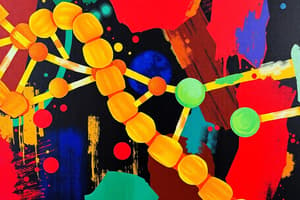Podcast
Questions and Answers
The building blocks of DNA are ___
The building blocks of DNA are ___
nucleotides
Nucleotides in DNA are made of three basic components: a sugar called ___, a ___, and a ____.
Nucleotides in DNA are made of three basic components: a sugar called ___, a ___, and a ____.
deoxyribose, phosphate group, nitrogenous base
DNA contains four kinds of nitrogenous bases: ___, ____, ____, and __.
DNA contains four kinds of nitrogenous bases: ___, ____, ____, and __.
adenine, guanine, cytosine, thymine
In DNA, ___ can be joined in any order.
In DNA, ___ can be joined in any order.
The nucleotides in DNA are joined by ___ bonds.
The nucleotides in DNA are joined by ___ bonds.
What does Erwin Chargaff's rule state?
What does Erwin Chargaff's rule state?
What did Rosalind Franklin contribute to our understanding of DNA?
What did Rosalind Franklin contribute to our understanding of DNA?
What did James Watson and Francis Crick determine about DNA?
What did James Watson and Francis Crick determine about DNA?
What are hydrogen bonds?
What are hydrogen bonds?
What is a nucleotide?
What is a nucleotide?
What is deoxyribose?
What is deoxyribose?
What is a phosphate group?
What is a phosphate group?
What is a nitrogenous base?
What is a nitrogenous base?
What is a base pair?
What is a base pair?
What is a double helix?
What is a double helix?
What is telomerase?
What is telomerase?
What is helicase?
What is helicase?
What does DNA polymerase do?
What does DNA polymerase do?
Study Notes
DNA Structure and Components
- DNA is composed of building blocks known as nucleotides.
- Each nucleotide consists of three components: a sugar called deoxyribose, a phosphate group, and a nitrogenous base.
- There are four types of nitrogenous bases in DNA: adenine (A), guanine (G), cytosine (C), and thymine (T).
- Nucleotides can be arranged in any order, allowing for genetic variability.
- Nucleotides in DNA are connected by covalent bonds, forming the backbone of the DNA strand.
Key Figures in DNA Research
- Erwin Chargaff established that the amount of adenine equals thymine (A=T) and guanine equals cytosine (G=C), a principle known as Chargaff's rules.
- Rosalind Franklin utilized X-ray diffraction to reveal the twisted helical structure of DNA.
- James Watson and Francis Crick proposed the double helix model of DNA based on X-ray data and other research findings.
DNA Composition and Functionality
- A nucleotide includes a 5-carbon sugar (deoxyribose), a phosphate group (P), and one of the four nitrogen bases (A, T, G, C).
- Deoxyribose serves as the sugar in the DNA backbone.
- The phosphate group contributes to the structural integrity of DNA.
- The term base pair refers to the pairing of nitrogen bases across the two strands of the DNA double helix.
Structural Features of DNA
- The double helix structure resembles a twisted ladder, with the sugar-phosphate backbone forming the sides and the nitrogenous bases forming the rungs.
- Telomerase is an enzyme associated with the tips of chromosomes, known as telomeres, which have repeating sequences.
- Helicase is an enzyme that unwinds the DNA helix during replication.
- DNA polymerase adds nucleotides to a growing DNA strand and also proofreads for accuracy.
Studying That Suits You
Use AI to generate personalized quizzes and flashcards to suit your learning preferences.
Description
Explore the fundamental components of DNA with these flashcards. Each card highlights essential terms and definitions, including nucleotides and nitrogenous bases. Perfect for anyone studying the molecular biology of DNA.





